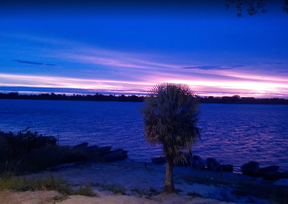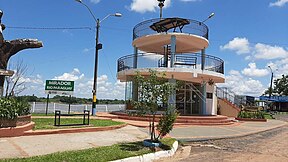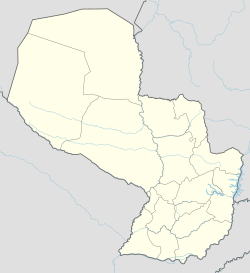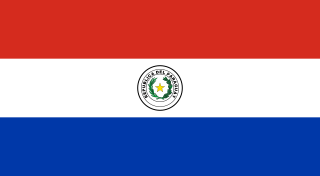
Paraguay, officially the Republic of Paraguay, is a landlocked country in South America. It is bordered by Argentina to the south and southwest, Brazil to the east and northeast, and Bolivia to the northwest. It has a population of around 6.1 million, nearly 2.3 million of whom live in the capital and largest city of Asunción, and its surrounding metro area.
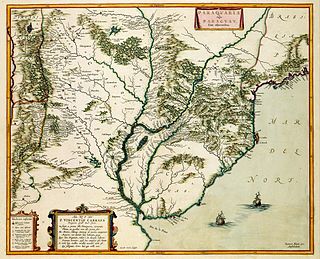
The history of Paraguay encompasses thousands of years of human habitation. Both agricultural and nomadic Guaycuruan lived in the region at the time of the Spanish Conquest. It became a relatively neglected part of the Spanish Empire due to its isolation and lack of mineral wealth, nonetheless a small group of Spanish settlers came to reside in the area, increasingly intermarrying with native women to produce a mestizo population. In the 17th and 18th centuries, Jesuit missionaries organized the natives into planned communities known as reducciones, and the experiment gained notable attention in Enlightenment Era Europe.

Asunción is the capital and the largest city of Paraguay. The city stands on the eastern bank of the Paraguay River, almost at the confluence of this river with the Pilcomayo River. The Paraguay River and the Bay of Asunción in the northwest separate the city from the Occidental Region of Paraguay and from Argentina in the south part of the city. The rest of the city is surrounded by the Central Department.

Francisco Solano López Carrillo was a Paraguayan military officer, politician and statesman who served as President of Paraguay between 1862 and 1870, of which he served mostly during the Paraguayan War (1864–1870). He succeeded his father Carlos Antonio López as the second president of Paraguay. He is the only Paraguayan president to have been killed in action. He is one of only two Paraguayans to have received the rank of Marshal, along with José Félix Estigarribia. He is officially recognized as the country's national hero since the presidency of Colonel Rafael Franco between 1936 and 1937 after decades of liberal governments that rejected his figure as heroic. The date of his birth, July 24, is officially recognized as the Paraguayan Army Day, while the date of his death, March 1, is officially recognized as the National Heroes' Day and is a national holiday in the country.

The "Paraguayan National Anthem" was officially adopted on 20 May 1846. The lyrics were written by Francisco Acuña de Figueroa under the presidency of Carlos Antonio López, who at the time delegated Bernardo Jovellanos and Anastasio González to ask Figueroa to write the anthem. The original composer of the song remains unclear, although the music is often attributed to Francesco Casale. Remberto Giménez rearranged the melody in 1933.

Guairá is one of the seventeen departments of Paraguay. Its capital and most populous city is Villarrica. It is located to the southern half of the country and to the center of the Eastern Region. Guaira is the second smallest department of Paraguay after Central and the fourth most densely populated after Central, Alto Parana and Cordillera. It was created in 1906.

Jopara or Yopará is a colloquial form of Guarani spoken in Paraguay which uses a number of Spanish loan words. Its name is from the Guarani word for "mixture".
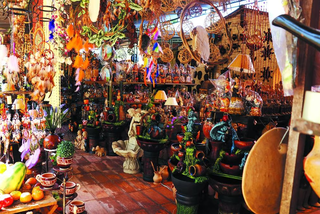
Areguá is a creative city and the capital of Central Department in Paraguay. It is known for its production of strawberry products, pottery, colonial architecture and historic cobblestone streets.

Encarnación is a district and the capital city of Itapúa Department in Paraguay, located at the south-east of the department, on the right-hand (western) shore of the Paraná River, opposite Posadas, Argentina. The city has an area of 274 km2 and a population of 93,497, and the Greater Encarnacion area has a population of over 225,000 according to a 2020 estimate. Encarnación is the third-largest city of Paraguay. The city was originally named Nuestra Señora de la Anunciación de Itapúa, and is considered the capital of summer by most of its inhabitants.

The Revolt of the Comuneros was a series of uprisings by settlers in Paraguay in the Viceroyalty of Peru against the Spanish authorities from 1721 to 1725 and 1730–1735. The underlying cause of the unrest was strong anti-Jesuit feelings among the Paraguayans and dislike for any governor seen as favoring the Jesuits. In the resumption of the revolt in 1730, economic issues came to fore as well. The rebel organization split in its second phase, as the rural poor and the urban elite each formed their own factions with similar grievances against the Jesuits, but incompatible politics. Paraguay had an unusually strong tradition of self-rule; the colonists did not have a tradition of strict obedience to everything the Spanish Crown's governor decreed. This independence helped push the revolt forward.
The Guarani alphabet (achegety) is used to write the Guarani language, spoken mostly in Paraguay and nearby countries. It consists of 33 letters.
José de Antequera y Castro was a Panamanian lawyer and judge in the Viceroyalty of Peru who worked with the Real Audiencia of Charcas. He traveled to Paraguay to investigate allegations of corruption against Governor Diego de los Reyes Balmaseda. Controversially, he found Reyes guilty and then took the position of Governor of Paraguay for himself in 1721. He defended his position even against explicit instructions from the Viceroy of Peru to hand the Governorship back to Reyes, and rallied the militia to fight off attempts by Spanish authorities to push him out of power. However, his position eventually became untenable, and under the threat of an overwhelming military response, he fled the governorship. He was eventually arrested and executed.

Abaí is a district of Caazapá, Paraguay. It is the biggest district of the department and one of the country's biggest agricultural zones.

Paraguayan cuisine is the set of dishes and culinary techniques of Paraguay. It has a marked influence of the Guaraní people combined with the Spanish cuisine and other marked influences coming from the immigration received by bordering countries such as Italian cuisine and German cuisine. The city of Asunción is the epicenter of the distinctive gastronomy that extends in current Paraguay and its areas of influence, which is the reason why is considered the mother of the gastronomy of the Río de la Plata. It is worth clarifying that in the Paraguayan society, the exchange of knowledge between mestizos, creoles and cario-guaraní people occurred before the Jesuit missions.
Diego de los Reyes y Balmaseda was the Governor of Paraguay from February 5, 1717 to August 20, 1721. His governorship was deeply unpopular with the inhabitants of Asunción, and an investigation by judge José de Antequera y Castro of the Real Audiencia of Charcas concluded that Reyes had abused his office, and he was deposed. Antequera took the governorship of Paraguay upon himself afterward, the beginning of the Revolt of the Comuneros. Reyes never recovered his governorship, and was eventually exiled from the province after a year-long imprisonment.
The development of a distinct architectural style in Paraguay is relatively recent. This is due partially to the European influence following the colonization of the country in 1537. With the arrival of Europeans, and especially the Spanish, the architecture of the country developed with the construction of brick built cathedrals, palaces and many other European-style monuments.
Capitán Carmelo Peralta, commonly known as Carmelo Peralta, is a Paraguayan city and district situated on the banks of the Paraguay River, on the border with Porto Murtinho, Mato Grosso do Sul, Brazil, approximately 716 km from Asunción, in the department of Alto Paraguay, Paraguay.
The 2023 Primera División season was the 89th season of the Paraguayan Primera División, the top-flight professional football league in Paraguay. The season consisted of two tournaments, Apertura and Clausura, and it began on 27 January and ended on 1 December 2023. The fixtures for the season were announced on 14 November 2022.
Graziella Corvalán was a Paraguayan sociologist and linguist most known for her efforts to preserve the Guarani language and for creation of one of the first women's studies programs in Paraguay. Her works stressed the need for public policies to eliminate discrimination on the basis of gender and language. She was recognized by the government of Paraguay in 2010 with the Grand Cross of the National Order of Merit. The following year, she was the recipient of the Serafina Dávalos Prize from the Municipal Board of Asunción and in 2022 was recognized by the United Nations Paraguay office.
